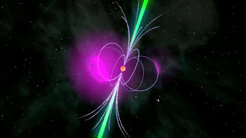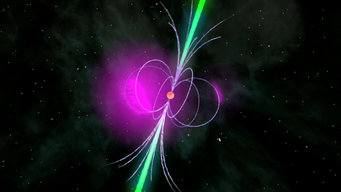A pulsar with a tremendous hiccup
Max Planck scientists discover young and energetic neutron star with unusually irregular rotation

Pure gamma-ray pulsars are difficult to identify because their characteristics, such as its sky position, the period of rotation and its change in time, are unknown. And astronomers can only determine their approximate position in the sky from the original Fermi observations. They must therefore check many combinations of these characteristics in a blind search, which requires a great deal of computing time. This is the only way of finding a hidden periodicity in the arrival times of the gamma-ray photons.
Even high-performance computers quickly reach their limit in this process. Therefore, the researchers used algorithms originally developed for the analysis of gravitational-wave data to conduct a particularly efficient hunt through the Fermi data. “By employing new optimal algorithms on our ATLAS computer cluster, we were able to identify many previously-missed signals,” says Bruce Allen, Director of the AEI. Back in November 2011, Allen’s team announced the discovery of nine new Fermi gamma-ray pulsars, which had escaped all previous searches. Now the scientists have made a new extraordinary find with the same methods.

The name of the newly discovered pulsar – J1838-0537 – comes from its celestial coordinates. “The pulsar is, at 5,000 years of age, very young. It rotates about its own axis roughly seven times per second and its position in the sky is towards the Scutum constellation,” says Holger Pletsch, a scientist in Allen’s group and lead author of the study which has now been published. “After the discovery we were very surprised that the pulsar was initially only visible until September 2009. Then it seemed to suddenly disappear.”
Only a complex follow-up analysis enabled an international team led by Pletsch to solve the mystery of pulsar J1838-0537: it did not disappear, but experienced a sudden glitch after which it rotated 38 millionths of a Hertz faster than before. “This difference may appear negligibly small, but it’s the largest glitch ever measured for a pure gamma-ray pulsar,” explains Allen. And this behaviour has consequences
“If the sudden frequency change is neglected, then after only eight hours, a complete rotation of the pulsar is lost in our counting, and we can no longer determine at which rotational phase the gamma-ray photons reach the detector aboard Fermi,” adds Pletsch. The “flashing” of the neutron star then disappears. If the researchers take the glitch into account and correct the change in rotation, the pulsar shows up again in the observational data.
The precise cause of the glitches observed in many young pulsars is unknown. Astronomers consider “star quakes” of the neutron star crust or interactions between the superfluid stellar interior and the crust to be possible explanations. “Detecting a large number of strong pulsar glitches makes it possible to learn more about the inner structure of these compact celestial bodies,” says Lucas Guillemot from the Max Planck Institute for Radio Astronomy in Bonn, the second author of the study. “This is a good example of the collaboration of two Max Planck institutes with complementary research foci,” says Michael Kramer, Director and Head of the Fundamental Physics in Radio Astronomy research group.
After the discovery in data from the Fermi satellite, the researchers pointed the radio telescope in Green Bank, West Virginia/USA at the celestial position of the gamma-ray pulsar. In an observation of almost two hours and by analysing a further, older, one-hour observation of the source they found no indications of pulsations in the radio range, indicating that J1838-0537 is a rare gamma-ray-only pulsar.
There were, however, noticeable overlays with observations of the High Energy Stereoscopic System ( H.E.S.S.) in Namibia, which searches for very-high-energy gamma radiation from the depths of space. In a survey with H.E.S.S., astronomers found an extended source of this radiation near the now discovered pulsar, but have not yet been able to clarify its nature.
The discovery of the pulsar suggests that the H.E.S.S. source is a pulsar wind nebula. These are produced by particles moving at almost the speed of light, which the pulsar accelerates in its extremely strong magnetic field. Since the exact position of the pulsar is now known, H.E.S.S. can take this into account in the future and to make more precise measurements than before in this celestial region.
The ATLAS computer cluster of the Albert Einstein Institute has thus already assisted in the discovery of the tenth previously unknown gamma-ray pulsar; however, Allen’s team has meanwhile mobilised further computing capacity. “Since August 2011, our search has also been running on the distributed computing project Einstein@Home, which has computing power a factor of ten greater than the ATLAS cluster. We are very optimistic about finding more unusual gamma-ray pulsars in the Fermi data,” says Bruce Allen. One goal of the expanded search is to discover the first gamma-ray-only pulsar with a rotation period in the millisecond range.
Background information
Pulsars
These cosmic beacons are compact neutron stars, born in supernova explosions, which rotate rapidly and steadily about their axis. Their intense magnetic field causes them to emit radio waves and gamma radiation. Their rotation sweeps the emission regions through space like the beam from a lighthouse. If the neutron star points towards Earth, it is visible as a pulsar. Not all pulsars show up in multiple spectral ranges. In some cases, the scientists measure only the flashing as a radio pulsar; in other cases, only the periodic arrival times of gamma photons can be registered. The latter type of pulsar is called a gamma-ray-only pulsar. The most likely cause for the different pulsar types are the different orientations of the emission regions in the extremely strong magnetic field of the neutron star.
But pulsars are even more mysterious: when they are young, their steady rotation is irregular, and disturbed by sudden, jerky accelerations known as glitches. Only about five percent of the pulsars exhibit this behaviour. In such a glitch, the neutron star suddenly rotates faster, then slowly decelerates again and returns to the old rotation period a few weeks later. Astronomers do not yet know why this happens, but accurate measurements of these glitches provide insights into the structure of the compact celestial bodies.
To date, astronomers have found most pulsars in the radio wave range, but thanks to NASA’s Fermi satellite they are finding more and more of these celestial bodies via their high-energy gamma radiation. Fermi has been observing the universe with its Large Area Telescope (LAT) in the gamma-rays since 2008. It has discovered hundreds of new sources, many of which are probably undiscovered pulsars.
Data analysis
When analysing data from gravitational wave detectors, scientists have to rely on very effective algorithms and high computing power. This is necessary, because a possible gravitational wave signal would be scarcely stronger than the background noise at the current measurement accuracy.
Within the LIGO-Virgo Science Collaboration (LVC), which also includes the German-British GEO600 detector in Ruthe near Hanover, all detector data are collected jointly, archived and made available for analysis. Several copies of around 500 Terabytes of data are stored at different computer cluster locations. When the detector network is running, one megabyte of data is generated every second. The largest and most powerful computing cluster is ATLAS at the AEI in Hanover. It has a peak computing power of 64 TFLOP/s (floating-point operations per second).
The data is analysed in several steps. First, the astrophysicists scan large areas of the sky for signals. If there is a conspicuous signal in one direction, they investigate the vicinity with an algorithm which has a narrower search grid and thus requires more computing time. If the signal is confirmed, the scientists analyse its temporal characteristic and examine whether it can be assigned to a specific pulsar period, for example. The Hanover scientists have modified the algorithm to search for continuous sources of gravitational waves and used it successfully to search for gamma-ray pulsars in Fermi data.
Einstein@Home
This project for distributed volunteer computing connects PC users from all over the world, who voluntarily donate spare computing time on their home and office computers. It has more than 320,000 participants and is therefore one of the largest projects of this kind. Scientific supporters are the Center for Gravitation and Cosmology at the University of Wisconsin-Milwaukee and the Max Planck Institute for Gravitational Physics (Albert Einstein Institute, Hanover) with financial support from the National Science Foundation and the Max Planck Society. Since 2005, Einstein@Home has examined data from the gravitational wave detectors within the LIGO-Virgo-Science Collaboration (LVC) for gravitational waves from unknown, rapidly rotating neutron stars.
As of March 2009, Einstein@Home has also been involved in the search for signals from radio pulsars in observational data from the Arecibo Observatory in Puerto Rico and the Parkes Observatory in Australia. Since the first discovery of a radio pulsar by Einstein@Home in August 2010, the global computer network has discovered more than 40 new radio pulsars. A new search for gamma-ray pulsars in data of the Fermi satellite was added in August 2011; the project is looking for, among other things, the first millisecond pulsar, visible only in the gamma-ray range.













